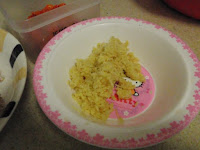Homemade Strawberry Ice Cream
Those who know me, knows that I am not so great a fan on strawberry ice-cream, or in fact any that taste like strawberry milk. I prefer the fresh clean taste of fresh strawberries. But my daughter begged and begged and I decided to make ice cream instead of sorbet. However, after it was made and I tasted it the second day, I realised it did not taste so bad as store bought strawberry ice-cream, in fact the chips of strawberries made it rather refreshing and so I just went on spoon after spoon on the scoop of ice cream which I insisted my husband taste for me.
The ice cream below was made over the period of 2 days. 3 days infact as I left it overnight on the second day for the churned ice cream to harden till store bought texture and my daughter was asking over and over and over again when she can have it. So you do need a little bit of planning if you intend to make this ice cream.
[Recipe Adapted from Making Artisan Gelato by Torrance Kopfer
Ingredients:
Strawberries Puree:
~400 g of strawberries
1 1/2 tbsp of sugar
1 tbsp of lemon juice
Strawberry Add in:
~200g of strawberries
3 tbsp of sugar
Ice Cream Base:
400 ml of fresh cream
350 ml of milk
120 g of castor sugar
2 egg yolks
Method:
First Day:
1. Making the Strawberry puree. Hull the strawberries for making strawberry puree. Cut them in halve. Add in sugar and lemon juice and toss well. Store them in refrigerator in an air tight container overnight. Puree the strawberry the next day (discard the juice that has been drawn out) in a blender till smooth.
2. Macerate the strawberry add-ins. Hull the strawberries. Cut into small bite size. Add in the suger, toss well and store them in another air-tight container overnight.
2nd Day:
3. On the second day. Heat the milk about 100 ml of the cream in the saucepan, together with the 1/2 the sugar on a stovetop over low flame. Stir constantly till the sugar has dissolved. When the milk has just bubbled, remove from stove top.
4. In a large bowl, break in the 2 large egg yolks, and remaining sugar. Whisk till the mixture foams and lighten.
5. Temper the eggs by slowly ladelling the 1/2 the amount of warm milk into the whisked eggs while whisking at the same time. Pour this mixture back into the warm milk saucepan.
6. Return the mixture back onto the stove at low flame. Heat the mixture while constantly stirring with a wooden spatula and scrapping the bottom of the pan till the mixture thickens and start coating the back of the spatular. Then remove the pot from the flame.
7. In a large bowl place ice, salt and water. Put another smaller mixing bowl (but must be able to still accommodate and mix) into the ice mixture. Pour the remaining cream into the mixing bowl and the cooked custard in (6) into the mixing bowl. Whisk till the mixture is well mixed and cooled down. Put the mixture into the refrigerator for at least about 4 hours.
8. Churn the mixture in 7 in the ice cream maker . When ready, transfer the ice cream into a plastic tub, stir in the strawberry mix-ins and freeze till storebought hardness.















